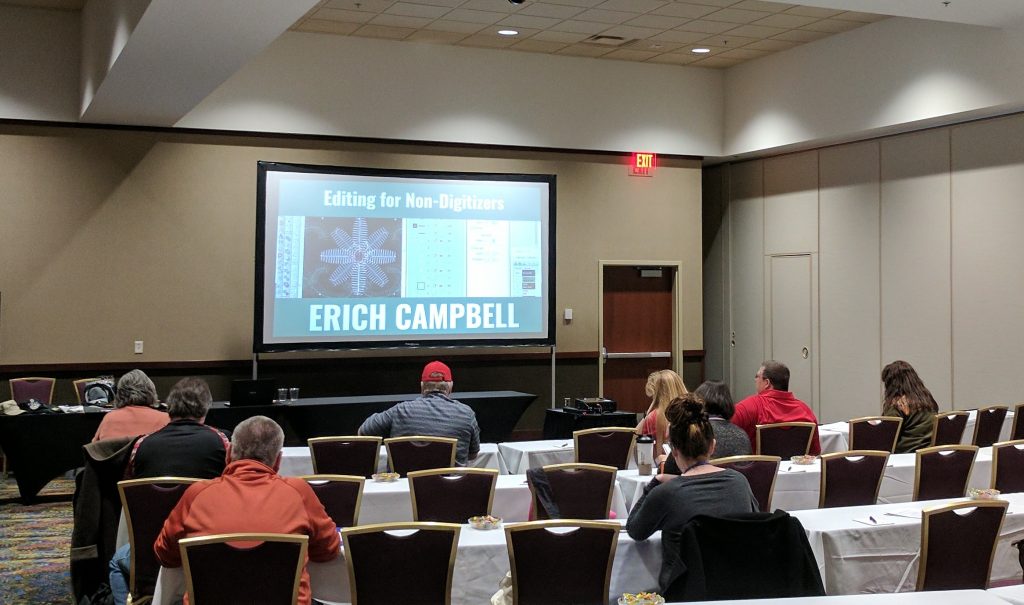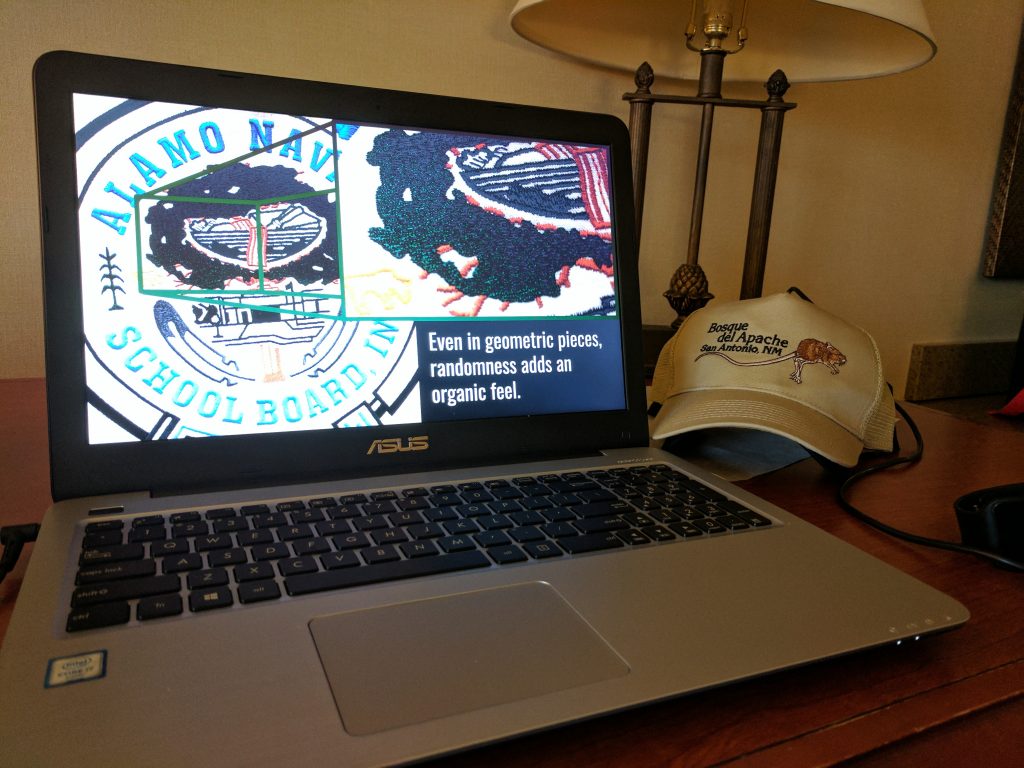Teaching isn’t just the best way to learn the subject you’re teaching, it’s the best way to find out how much you still have to learn.
I’ve recently concluded my first series of seminars on machine embroidery for the fantastic people at the Decorated Apparel Expo (affectionately known as DAX). I taught at shows in Kanasas, Minnesota, and Illinois, with a total in the range of close to 100 embroiderers, from every skill level from seasoned digitizers to some who had only recently come into the craft.

The early birds getting ready for my class- think my name is big enough?
For each show, I held my longer seminar in the afternoon before day 1, lasting roughly 4 hours with the Q&A that followed. Entitled ‘Demystifying Next Level Digitizing‘, I lectured on adding dimension to designs, how to control and use the surface quality of embroidery through stitch types and parameters, finishing with a section on design analysis that might be the most important thing I’ve ever shared. I followed that with a shorter session in the early morning before the show-floor opened. I called that session ‘Editing for Non-Digitizers’ leading it off with an explanation of how to tame textured materials, working through refining text, continuing with a discussion of manual techniques to add all-important underlay stitching, and concluding with correcting registration problems in designs. I told you all that to tell you this; despite how complete and worthwhile I felt that my classes were, or how many ecstatic pats on the back followed on the show floor, the interaction shared after the sessions may well have had the most impact. This isn’t just to say that the personal time I spent answering questions or discussing techniques made the difference; I mean that in the unplanned moments of interaction between myself and the attendees, and between the attendees themselves, we managed to expand and enrich the experience beyond what can come from a completely one-sided speech from the front of the room.

Never not reviewing slides in the hotel; The prep never ends.
I had already planned to leave a goodly amount of time for questions. I have always been of the mindset that learning at an in-person event is better than self-directed online classes specifically due to the communal interaction among the attendees. Certainly, there’s great value in the mini-consultations you get when a speaker gives you immediate feedback during the informal interactions surrounding the class, but the discussion of each decorator’s needs coupled with the congregation of diverse viewpoints is just as critical, even when the speaker provides the experience to answer the arrived-upon questions. It’s in these discussions and Q&A sessions that we arrive at common issues among decorators and hear pertinent questions we may have never thought to ask. Though I had a flattering amount of positive commentary about my teaching, I felt that it was largely improved by encouraging this interchange. When real-world questions are on the table, samples are in hands, and the theory starts to meet the varied experiences of the decorators, that’s when the energy is highest and much of the most important work gets done. It’s also where I as an educator get my chance to learn from the attendees.
With that in mind, here are a few of the many things I learned through these face to face experiences: (Feel free to comment on the post with your own conclusions; we can only learn more by continuing the discussion!)
Decorators want details: If you vaguely describe the way you stitch something, be ready to state all the materials you used and every measurement you can muster. Don’t come to the table with concepts, come with recipes. It’s not that there’s no room for theory, but you should expect the pointed questions that would lead to these details to come up quickly in the Q&A if you don”t touch at all on the numbers, the equipment, the tools, materials, and brands you use to make things happen. The attendees of a business-focussed presentation, no matter how creative the venue or topic, most often want to be presented with at least some solid solutions.
What you show is what you’ll discuss: If you bring a sample or show an image that is striking but somehow unrelated to your topic, you’ll be teaching the technique behind it after your slide deck is exhausted. If you show it, it’s on the table for discussion. This was especially poignant to me, as in teaching decorators how to get the kind of jobs that they want to do in the future, I’ve always said that ‘The work you share is the work you’ll do” referring to the same effect as it pertains to decorating. If you love monogramming, show monograms- people will see those and associate you with that work; that’s the work they’ll bring. The same thing can be said of setting up for a class. My experience had to do with patches; though I didn’t discuss patch-making at any session (though I have written about it MANY times), I had patches on my sample table, and every session had me explaining how I made them in detail, no less than twice.

I won’t teach patch making again. Yeah and monkeys might fly out of my . . . embroidery machine.
Everyone needs to be heard and understood: It’s not every day you can let loose about a design you worked on and what the underlay did when you switched from a twill shirt to a fleece jacket and have someone understand why that matters. Even with the few very experienced digitizer who decided to attend, and who truthfully knew most of the things I was teaching, they generally left quite happy. First, because they each told me that there was some element of what I taught that was new to them (This is how they remained in the game long enough to be so seasoned; the beginner’s mindset is critical. There’s always more to learn), second, because after the sessions, on the floor, or even in the restaurant or after-party, I took the time to engage with them, talk to them about their work, and hear them out. Even though I may not have had much that was entirely new to teach them in the session, our shared experience made me a compatriot and an understanding audience to whom they could tell their story and expect to see nodding and head-shaking at all the right places in the story.
People need Reassurance: I have always said that teaching, whether online or off, is at least 75% instruction and 25% encouragement, This was widely confirmed in my sessions at DAX. A great number of the decorators are somewhat sheepish to ask a question, but when other decorators in their vicinity hear the question and audibly show interest, the anxiety drains away and the question becomes a matter of factual exploration rather than personal judgment and anxiety. I’ve often had a decorator ask me a question and then provide a thoroughly correct explanation of how to handle the problem at hand. Once I confirmed their concept, even with very little in the way of additional information, the tension would fade from their faces and they would be amped to get back to their shops and attempt the next phase of testing on whatever problem they were having or technique they were trying to develop. The truth is that many people feel the need to be forgiven their failures or told that they have the right to experiment, fall flat, and try again without ridicule.
In the end, I like to believe I gave a good value for the attendees, but I must admit that I gain greatly from the experience as well. It’s one of the reasons I encourage people to teach at every stage in their careers. You never know when the little you feel you have to share is critical to your audience, nor do you know when the questions they have to ask might lead you to your next big breakthrough.
You are so right. As much as I am learning abot digitizing no matter what I do ( screw ups and all) I look forward to the comments and encouragement








I really enjoyed this post Erich. It is a great reminder of how rewarding it can be to share your knowledge and to connect with like-minded folks who understand your triumphs and challenges.